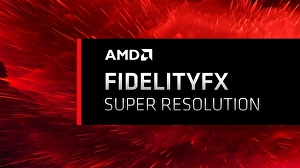
AMDs FidelityFX Super Resolution is finally here, and we've been able to test it out across a number of titles. The idea here is pretty straightforward: to dramatically increase performance while minimising the hit to image quality. So the questions we had going into this one were simple enough: how does FSR actually work? How does it look in comparison to native resolution imagery? And how does it stack up against top-end temporal upscaling solutions, like the excellent technique built into Unreal Engine 4? We can answer those questions today, but what we cannot do is offer any comparisons to Nvidia's DLSS: test material simply isn't available.
So how does FSR actually work? To its credit, AMD has been open with journalists about this in the run-up to launch. FSR is essentially a single frame spatial imagine enhancement technique that looks for edges and resolves those them smartly into a higher resolution grid. Jaggies and shimmer from standard upscaling are the worst upscaling artefacts and FSR aims to comprehensively address this. However, all the upscaler has to work with is the standard image – it does not gain any additional information from prior frames, neither are specific buffers isolated or rendered at a higher resolution. By default, it also 'inherits' whatever anti-aliasing solution is in play – typically TAA. So FSR does not replace TAA and cannot improve upon its flaws. The lack of a temporal component means that in-surface detail – the image 'inside' the edges – does not gain any further information, so resolves in a less distinct manner. AMD uses its contrast adaptive techniques here seen in CAS, but this cannot resolve extra detail.
So, with this information in mind, I started out by looking at Godfall – one of AMD's key games in its FSR press materials. At native 4K, there's a very crisp image and high frequency texture detail on ground artwork and foliage, plus the character's hair. Ultra quality FSR runs internally at 1662p instead, and even with the best FSR option in play, the inherently pristine nature of the presentation is definitely not quite the same. FSR is a single frame technique searching for edges, so inner surface detail looks to my eye to resolve in a similar manner to the 1662p internal resolution. Areas of the image composed of sub-pixel detail – like hair strands for example – also show visible breakup. This is inevitable when upscaling a lower resolution image that has no temporal accumulation. One area that I think fares very well in comparison to native quality in ultra quality mode are the edges of geometric objects. If we look at their edges and not their inner surface detail, we can see very similar levels of edge resolve between the two here. This is FSR's major strength.



